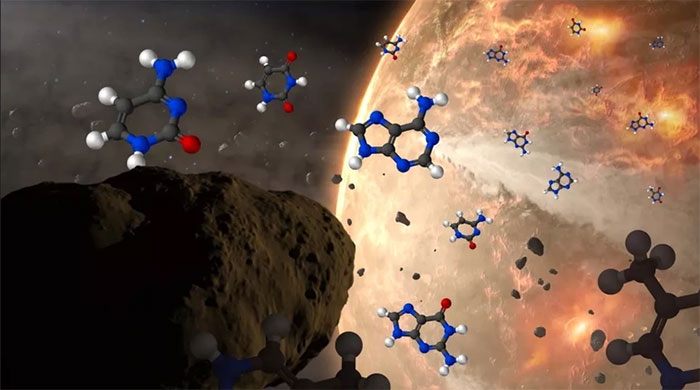Life on Earth may have been 'sent' from space
DNA is inherently made up of four major building blocks of life (nucleobases), called adenine (A), thymine (T), cytosine (C) and guanine (G). Meanwhile, the "DNA's brother" molecule, RNA, also uses A, C, and G, but swaps thymine for uracil (U).

These nucleobases are found in DNA and RNA in meteorites that have come to Earth
Scientists have long hypothesized about the origin of these masses, wondering if meteorites were the "train" that brought them to Earth. But so far, they have only found A and G in space rocks. And T, C and U are still unknowns.
However, in a recent discovery, scientists from Hokkaido University, Japan claim that they have found the "complete" of all 5 nucleobases - which exist in two forms as purines (with the nucleus made from a hexagonal molecule, fused with a pentagonal molecule) and pyramid (a structure made of only one hexagonal molecule).
To come to this conclusion, the scientists analyzed samples from three carbon-rich meteorites, including the Murchison, Murray and Tagish meteorites. In which, 3 missing nucleobases, T, C and U, were detected even at very low levels of a few parts per billion, but in sufficient concentrations at levels comparable to those found in laboratory reproduction experiments.
According to the scientists, these nucleobases are found in DNA and RNA in meteorites that have come to Earth. Therefore, the hypothesis that life on Earth may have been "sent" from space is probably completely valid.
"The presence of five major nucleobases in meteorites may have contributed to genetic functions, even before life began on Earth," said Yasuhiro Oba, the study's lead author and one of the researchers. astrophysicist at Hokkaido University, Japan.
From this result, Oba and colleagues even suggest that these "genetic letters" may have existed since before the formation of the Solar System, and that they could actually act as "trains". ", bringing life to every corner of the universe.
The project's researchers detailed their findings in the journal Nature Communications, published April 26.
- Find the 'Second Earth' that contains life?
- No longer a movie, the risk of alien bugs coming to earth is real
- Why does life appear on Earth instead of Venus?
- Life on Earth begins with volcanoes?
- What opportunities for humans when they cannot live on Earth?
- Scientists think that these are the eight most likely cases of life eradication
- Comets and asteroids sprinkle life across the galaxy?
- The Milky Way might contain 10 billion Earth-like planets
- When did life on Earth really begin?
- The process of formation and evolution of life on Earth
- Who will rule the Earth in the future?
- the truth about aliens?
 Biography of hero Vu A Dinh
Biography of hero Vu A Dinh History of hematology
History of hematology Who is Mr. Tam Da 'Phuc-Loc-Tho' and what does it mean?
Who is Mr. Tam Da 'Phuc-Loc-Tho' and what does it mean? Unbelievable facts about the history of the oil and gas industry: Gasoline used to be cheaper than water, so abundant that it had to be dumped into the river...
Unbelievable facts about the history of the oil and gas industry: Gasoline used to be cheaper than water, so abundant that it had to be dumped into the river...